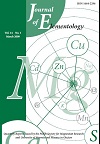Influence of the Głogów copper works on the content of mobile forms of copper and zinc in arable soils
Issue: 1/2012
Recevied: No data
Accepted: Brak danych
Published: May 4, 2012
Authors:
Brak danych
Categories: Agricultural, Pollution and environment
DOI: jelem.2012.17.1.05
Abstract:
The aim of this research has been to investigate the influence of the Głogów Copper Works on profile distribution and mobility of copper and zinc in cultivated soils in the vicinity of the plant. The following were determined in soil samples from 4 cultivated soil profiles classified as Luvisols: soil texture, pH in KCl, pH in H2O, organic carbon, total Cu and Zn content using the ASA method after mineralization in HF and HClO4 acids and the content of mobile forms of Cu and Zn using the sequential method. In terms of grain size distribution, the profiles were classified as loamy silt. The soil pH was in range of pHH2O 7.33-8.55 and pHKCl 5.81-7.75. Except for P1 profile, the presence of CaCO3 was observed in all soil profiles. C and Bt horizons were the richest in CaCO3. The content of C-organic in humus horizons was in the range of 7.0-18.1 g kg–1. The total Cu content was in the range of 4.04-57.75 mg kg–1. In Ap horizons, the total Cu content was significantly higher, but in C horizons it was the lowest, which indicates that Ap horizons had been enriched with Cu by human activity. The results of the sequential analysis indicate the dominant share of frac- tion V, associated with organic matter, in the surface horizons. In the remaining horizons, the Cu fraction associated with iron oxides dominates. The total content of Zn was in the range of 3.34-42.65 mg kg–1. The highest content of this element was observed in Ap horizons, and the lowest occurred in Eet horizons. The speciation analysis showed the highest content of Zn in the form associated with crystalline iron oxides (fraction VI), and the lowest in fractions I and II, i.e. soluble in water and exchangeable forms. Most of the investigated soils (apart from P1 profile) may be classified as unpolluted with Cu and Zn, which shows that the proximity of the Głogów Copper Works does not preclude agricultural use of the analyzed soils (with one exception).
Citation:

Jaworska H., Dąbkowska-Naskręt H. 2012. Influence of the Głogów copper works on the content of mobile forms of copper and zinc in arable soils. J. Elem. 17(1): 57-66.
Keywords:
soils, copper, zinc
About issue:

17.1.2012
Jsite


